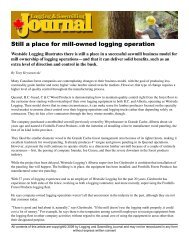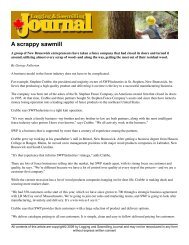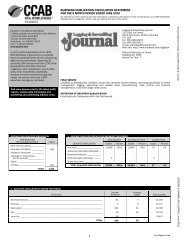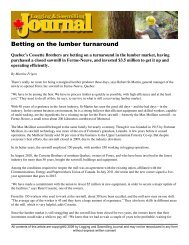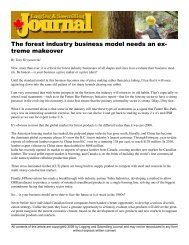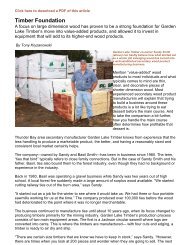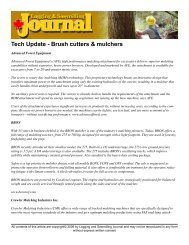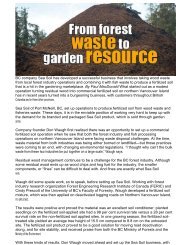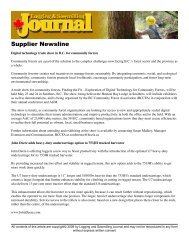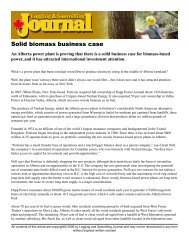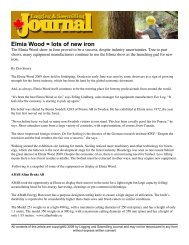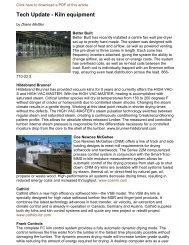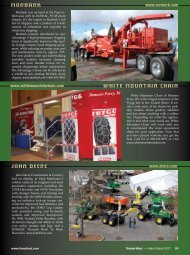Log Max heads tackle west coast wood .pdf - ForestNet
Log Max heads tackle west coast wood .pdf - ForestNet
Log Max heads tackle west coast wood .pdf - ForestNet
Create successful ePaper yourself
Turn your PDF publications into a flip-book with our unique Google optimized e-Paper software.
for handling the large and heavy <strong>coast</strong>al <strong>wood</strong>. “He really liked the power it delivered,” recalls Pierce.<br />
To make this long story shorter, that was way back in 1997—and since then Challenger Enterprises has been a very<br />
faithful, and satisfied, <strong>Log</strong> <strong>Max</strong> customer. They have had a number of <strong>Log</strong> <strong>Max</strong> <strong>heads</strong>, including three 750 <strong>heads</strong>. Then<br />
they went to the 9000 <strong>heads</strong>, and these days they now have the latest large head, the <strong>Log</strong> <strong>Max</strong> 10000XT.<br />
Pierce admits there have been challenges along the way, and he credits logging equipment veteran Olle Melin and <strong>Log</strong><br />
<strong>Max</strong>, for helping him through some difficult patches.<br />
There were some trying times with the <strong>Log</strong>Mate computer, and its measurement system. It was originally designed for<br />
short <strong>wood</strong>. “It can be hard with some of the computer systems on logging equipment,” says Pierce. “You can solve three<br />
problems, and it creates another four problems.”<br />
Essentially, over the years, Pierce, like a lot of other logging contractors, has gone from fixing equipment such as processing<br />
<strong>heads</strong> with wrenches to fixing them with a laptop computer.<br />
Pierce says he has always let <strong>Log</strong> <strong>Max</strong> know that he is happy to work with them on new equipment, and demo it. “I’ve<br />
said to them, if you’ve got some ideas you want me to work with, if you’ve got something new, bring it over. I’ll put in on<br />
and try it out.<br />
“I’ll gladly try it out, but I won’t necessarily buy it,” he added. As the saying goes, famous last words.<br />
Pierce has operators who have run all kinds of harvesting and processing <strong>heads</strong> for a long time, and they’re happy to<br />
provide opinions and assessments of equipment.<br />
“We tried the <strong>Log</strong> <strong>Max</strong> 10000XT and it is very impressive,” says Pierce. “The way things are going on Vancouver Island,<br />
the <strong>wood</strong> is getting smaller and smaller. So we can do about 90 per cent of the work we need to do mid-Island with the<br />
<strong>Log</strong> <strong>Max</strong> 7000 and 9000.<br />
“But once we get up to the North Island, around Campbell River, the <strong>wood</strong> is a lot heavier.” He notes that timber in the<br />
B.C. Interior is about .8 metric tonnes per cubic metre, and on the south island it’s about 1.0 metric tonnes per cubic<br />
metre. On the North Island, it comes in at about 1.2 tonnes per cubic metre.<br />
“That’s quite a difference,” he says. “You notice it—it’s harder on the equipment. And with the ground, it’s tough to get<br />
around, with higher stumps. It’s a different logging world.”<br />
Pierce notes that they run four <strong>Log</strong> <strong>Max</strong> processing <strong>heads</strong>, and they don’t need the 10000XT everywhere they work—<br />
simply because they don’t have big <strong>wood</strong> on every site. Having said that, the 10000XT clearly does the job for them,<br />
handling the larger <strong>wood</strong>.<br />
All contents of this article are copyright© 2009 by <strong>Log</strong>ging and Sawmilling Journal and may not be rerpoduced in any form<br />
without express written consent



